
Banksia grandis, commonly known as bull banksia or giant banksia, is a species of common and distinctive tree in the south-west of Western Australia. The Noongar peoples know the tree as beera, biara, boongura, gwangia, pira or peera. It has a fire-resistant main stem with thick bark, pinnatisect leaves with triangular side-lobes, pale yellow flowers and elliptical follicles in a large cone.

Banksia serrata, commonly known as the saw banksia, the old man banksia, the saw-tooth banksia or the red honeysuckle and as wiriyagan by the Cadigal people, is a species of woody shrub or tree of the genus Banksia, in the family Proteaceae. Native to the east coast of Australia, it is found from Queensland to Victoria with outlying populations on Tasmania and Flinders Island. Commonly growing as a gnarled tree up to 16 m (50 ft) in height, it can be much smaller in more exposed areas. This Banksia species has wrinkled grey bark, shiny dark green serrated leaves and large yellow or greyish-yellow flower spikes appearing over summer. The flower spikes, or inflorescences, turn grey as they age and pollinated flowers develop into large, grey, woody seed pods called follicles.

Banksia goodii, commonly known as Good's banksia, is a species of prostrate shrub that is endemic to a small area in the south-west of Western Australia. It has densely hairy stems, wavy, oblong to egg-shaped leaves with irregularly serrated margins, rusty-brown flowers and hairy fruit. It grows in low forest and woodland near Albany and is listed as "endangered".
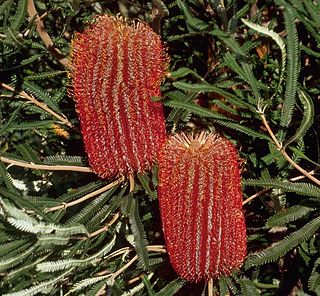
Banksia brownii, commonly known as feather-leaved banksia or Brown's banksia, is a species of shrub that grows in southwest Western Australia. An attractive plant with fine feathery leaves and large red-brown flower spikes, it usually grows as an upright bush around two metres (7 ft) high, but can also occur as a small tree or a low spreading shrub. First collected in 1829 and published the following year, it is placed in Banksiasubgenus Banksia, section Oncostylis, series Spicigerae. There are two genetically distinct forms.

Banksia baxteri, commonly known as Baxter's banksia or bird's nest banksia, is a species of shrub that is endemic to Western Australia. It has greyish brown bark, hairy stems, deeply serrated leaves with triangular lobes and lemon-yellow flowers in an oval flower spike that grows on the end of branches.

Banksia candolleana, commonly known as the propeller banksia, is a species of shrub that is endemic to Western Australia. It has shiny green, deeply serrated leaves with triangular lobes and spikes of golden yellow flowers on short side branches.

Banksia hookeriana, commonly known as Hooker's banksia, is a species of shrub of the genus Banksia in the family Proteaceae. It is native to the southwest of Western Australia and can reach up to 4 m (13 ft) high and 3 m (9.8 ft) wide. This species has long narrow serrated leaves and large, bright flower spikes, initially white before opening to a bright orange that appear over the cooler months. The flowers are pollinated by honeyeaters. The ageing flower spikes develop woody seed pods known as follicles. B. hookeriana is serotinous — large numbers of seeds are stored in the plant canopy for years until the plants are burnt by bushfire.

Banksia littoralis, commonly known as the swamp banksia, swamp oak, river banksia or seaside banksia and the western swamp banksia, is a species of tree that is endemic to the south-west of Western Australia. The Noongar peoples know the plant as pungura, boongura or gwangia. It has rough, crumbly bark, linear, more or less serrated leaves arranged in whorls, yellow flowers and up to two hundred follicles in each head.

Banksia meisneri, commonly known as Meisner's banksia, is a shrub that is endemic to a small area in the south-west of Western Australia. It has crowded, more or less linear leaves and in winter and spring, spikes of golden brown flowers followed by furry fruit which usually only open after fire.
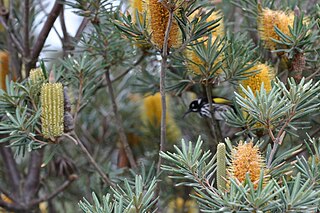
Banksia verticillata, commonly known as granite banksia or Albany banksia, is a species of shrub or (rarely) tree of the genus Banksia in the family Proteaceae. It is native to the southwest of Western Australia and can reach up to 3 m (10 ft) in height. It can grow taller to 5 m (16 ft) in sheltered areas, and much smaller in more exposed areas. This species has elliptic green leaves and large, bright golden yellow inflorescences or flower spikes, appearing in summer and autumn. The New Holland honeyeater is the most prominent pollinator, although several other species of honeyeater, as well as bees, visit the flower spikes.

Banksia victoriae, commonly known as Woolly Orange Banksia, is a species of large shrub or small tree in the plant genus Banksia. It occurs in Western Australia between Northampton, Western Australia and Kalbarri, with the occasional plant further north as far as Zuytdorp Nature Reserve.

Banksia epica is a shrub that grows on the south coast of Western Australia. A spreading bush with wedge-shaped serrated leaves and large creamy-yellow flower spikes, it grows up to 3½ metres (11½ ft) high. It is known only from two isolated populations in the remote southeast of the state, near the western edge of the Great Australian Bight. Both populations occur among coastal heath on cliff-top dunes of siliceous sand.
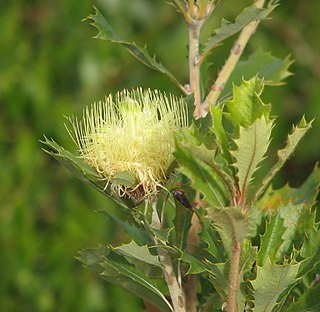
Banksia anatona, commonly known as the cactus dryandra, is a flowering plant in the family, Proteaceae and is endemic to Western Australia. It is a tall, spindly shrub with unusually large fruiting follicles. It is only known from a single location and has been classified as Critically Endangered nationally under the Environment Protection and Biodiversity Conservation Act 1999. The only known population is in danger of extinction from dieback disease.
Banksia brunnea is a species of low, bushy shrub that is endemic to the south-west of Western Australia. It has dark green pinnatisect leaves, heads of up to seventy pink and brownish flowers and glabrous follicles in the fruiting head.

Banksia alliacea is a species of shrub that is endemic to southwestern Western Australia. It grows to 2 m high and wide, with shaving brush-shaped inflorescences that smell of onions.

Two Peoples Bay Nature Reserve is a protected area managed by the Department of Parks and Wildlife 35 kilometres (22 mi) east of Albany, Western Australia. The area is accessible by 2WD vehicles. The bay itself, including two small secluded beaches, faces due east and is protected from the Southern Ocean by a headland formed by the granite massif of Mount Gardiner. The nature reserve was established in 1967 to protect the threatened noisy scrub-bird and its habitat.
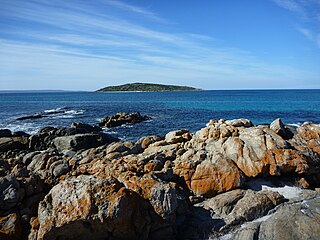
Cape Riche is a cape and rural locality in the Great Southern region of Western Australia. By road, it is 525 km south-east of Perth and 123 km north-east of Albany
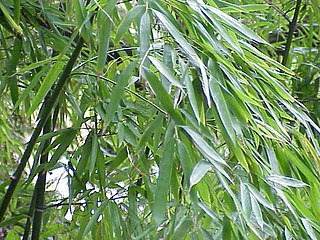
Phyllostachys aurea is a species of bamboo, and is of the 'running bamboo' type, belonging to the diverse Bambuseae tribe. It is native to Fujian and Zhejiang in China. It is commonly known by the names fishpole bamboo, golden bamboo, monk's belly bamboo, and fairyland bamboo (Australia).

Calectasia cyanea, commonly known as the star of Bethlehem or blue tinsel lily, is a plant in the family Dasypogonaceae growing as a perennial herb and is endemic to the south–west of Western Australia. Restricted to a single population in Torndirrup National Park, it is critically endangered.
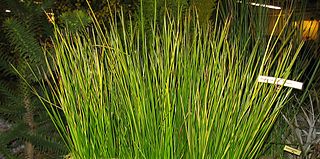
Machaerina rubiginosa, commonly known as soft twig rush, flat leaf twig rush or common twig rush, is a flowering plant in the sedge family, Cyperaceae, that is native to Asia and the Pacific.



















